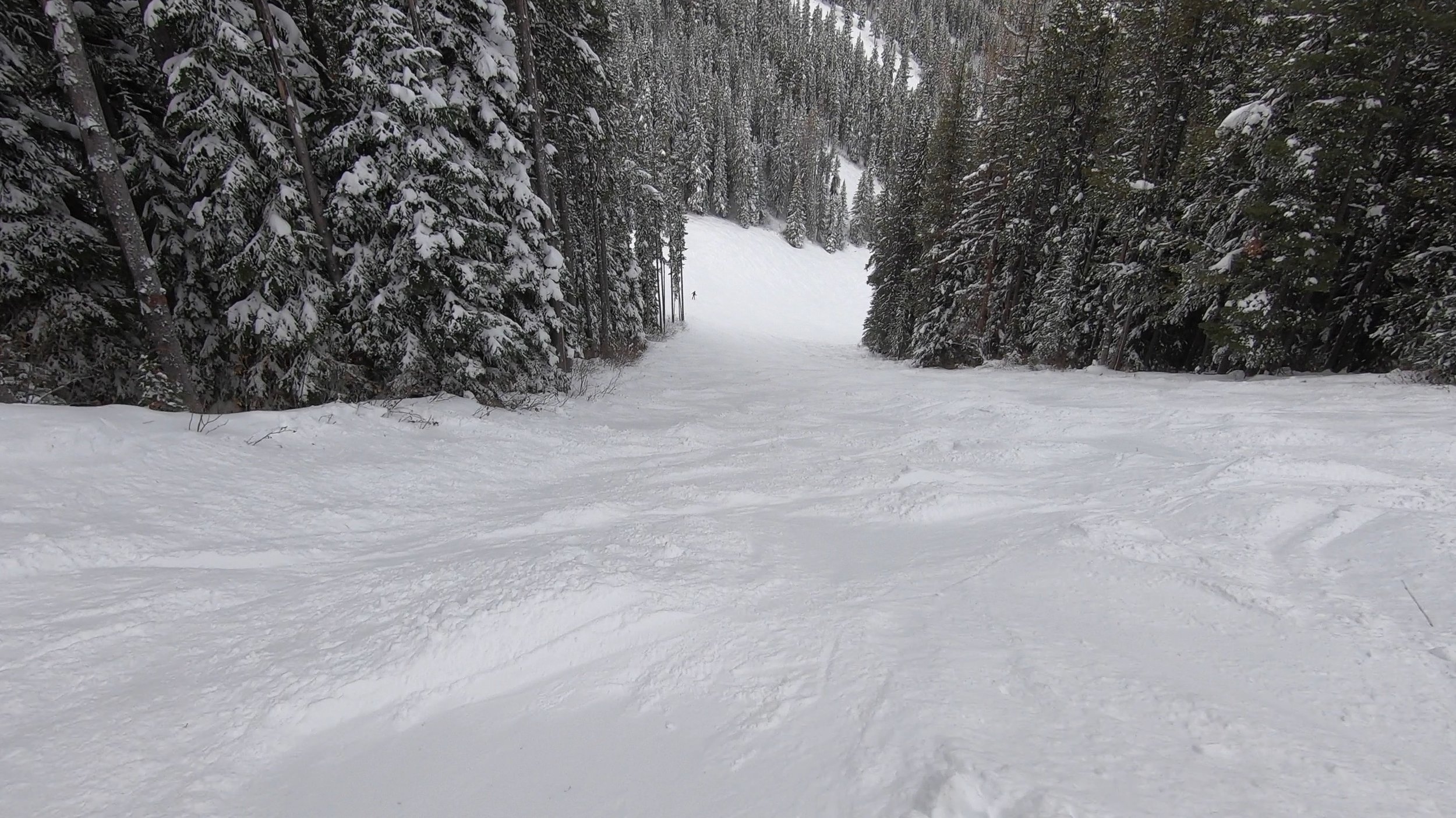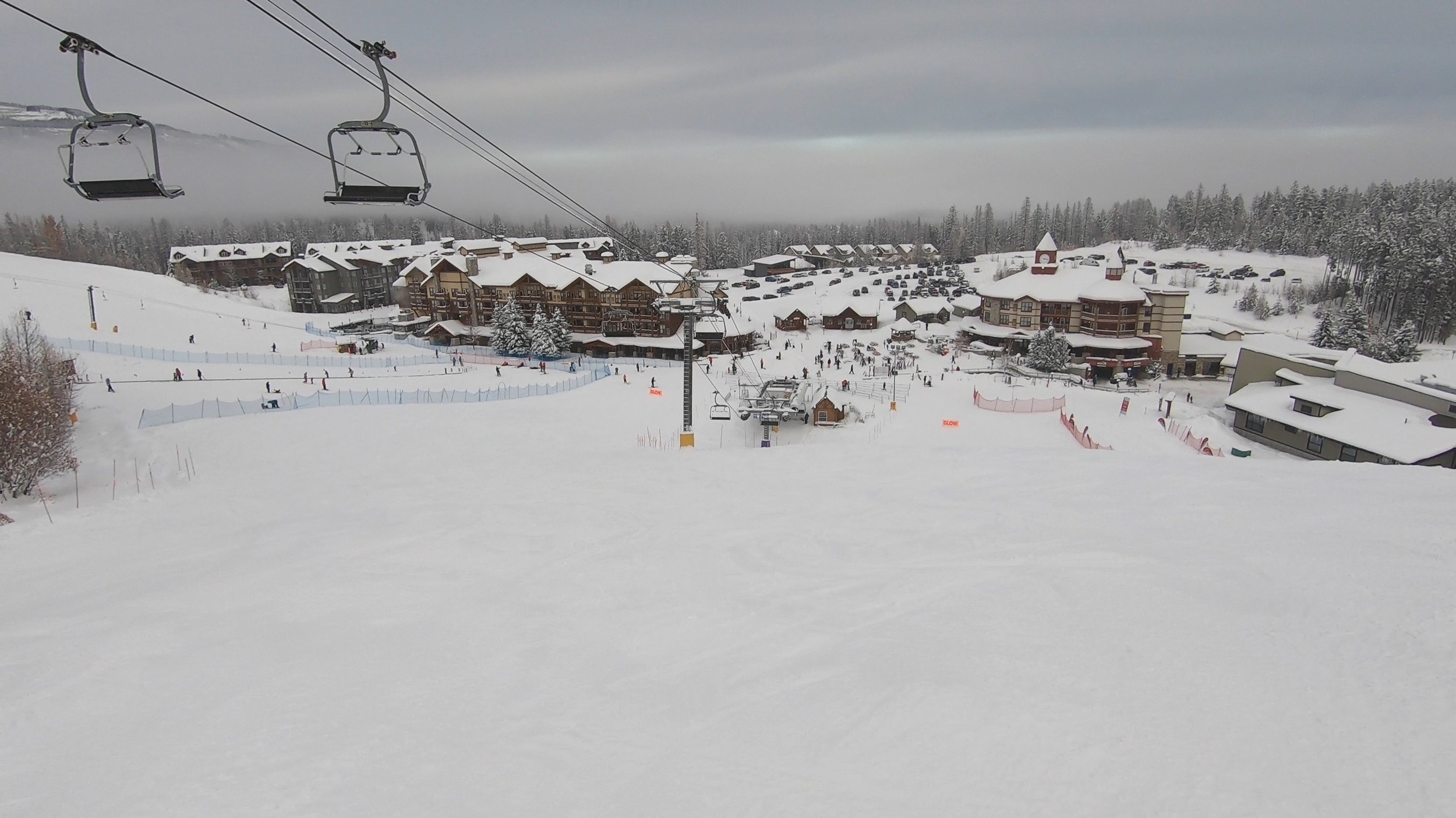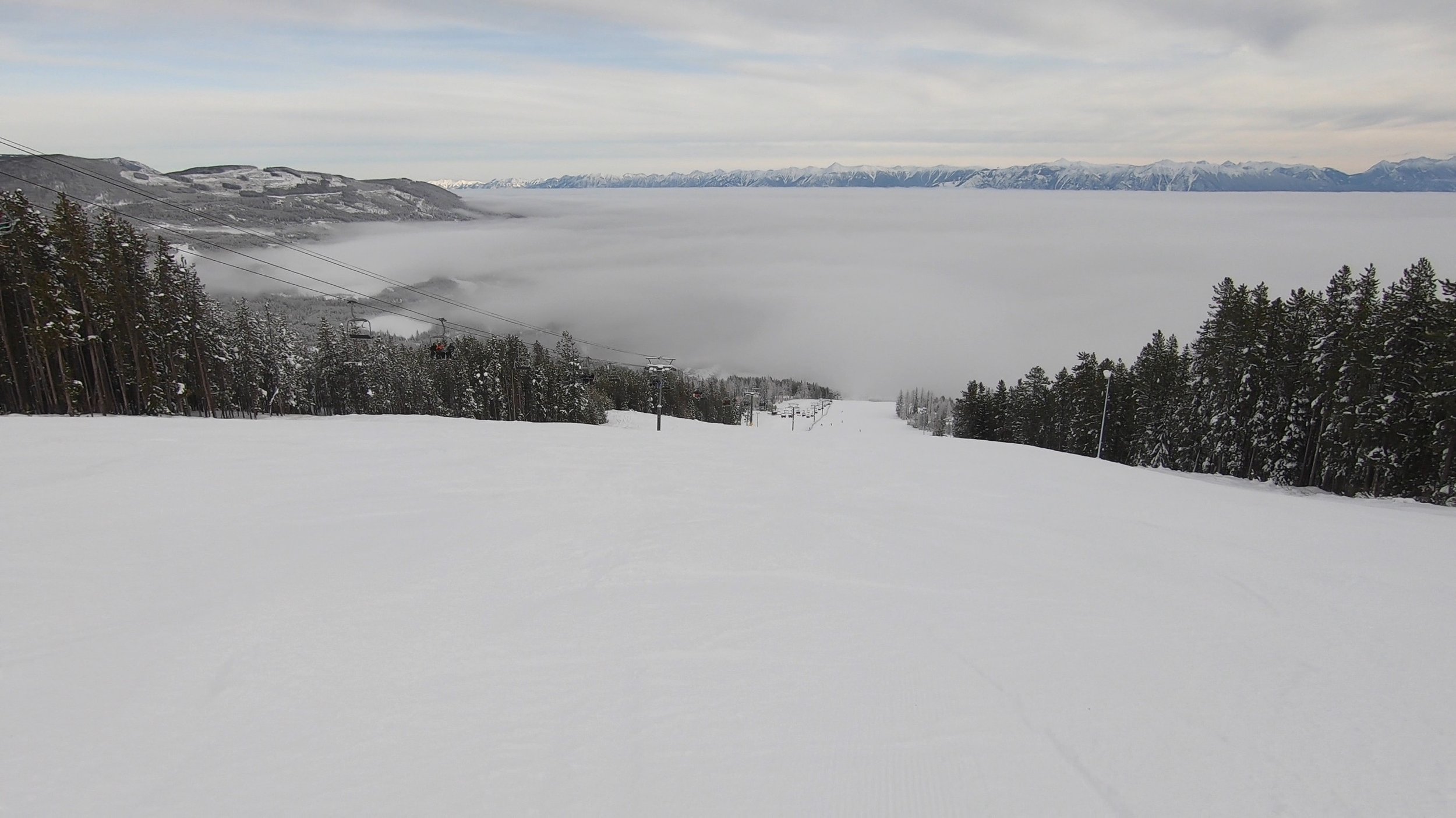Mountain Review: Kimberley
MOUNTAIN SCORE
CATEGORY BREAKDOWN
See our criteria7
Snow:
8
Resiliency:
6
Size:
4
Terrain Diversity:
5
Challenge:
5
Lifts:
7
Crowd Flow:
4
Facilities:
8
Navigation:
6
Mountain Aesthetic:
GOOD TO KNOW
1-Day Ticket: $73-$101 USD ($101-$139 CAD)
Pass Affiliation: Epic Pass (full pass only)
On-site Lodging: Yes
Aprés-ski: Limited
Nearest Cities: Spokane (4 hrs), Calgary (4.5 hrs)
Recommended Ability Level:
+ Pros
Family-friendly terrain
Straightforward footprint
Low crowds
Ticket and nearby accommodation value
– Cons
Modestly-sized, ordinary footprint
Lower snowfall totals than competitors
Misleadingly difficult beginner terrain
Ease of travel from most U.S. cities
MOUNTAIN STATS
Lifts: 5
Trails: 80
Beginner: 20%
Intermediate: 42%
Advanced/Expert: 38%
RECENT ARTICLES
Mountain Review
Located in the heart of the Purcell Mountains, Kimberley is a bit of a hidden entity among Western Canada mountains. The resort’s modest size, remote location, and short vertical drop mean it’s often overshadowed by better-known destinations. However, Kimberley brings a couple of notable benefits that make it a solid choice for skiers and riders in the region, including those on an Interior British Columbia road trip.
Snow Quality and Conditions
Starting at a 4,000-foot (1,200-meter) base elevation, Kimberley sits slightly higher than other Kootenay region ski resorts. The resort’s modestly higher elevation and somewhat drier climate make for lighter accumulation than some competitors. Kimberley rarely sees serious crowds, and the low visitation means fresh snow can take days to get tracked out.
However, Kimberley only receives about 150 inches of annual average snowfall each winter, making for much lower snow totals than the best-known North American destinations—and even many regional competitors. Kimberley tends to receive a large portion of its snow earlier in the season, making this issue less pronounced in December and January, and even making Kimberley a genuinely reliable choice for that time of year. On the other hand, Kimberley starts to see spring-like conditions around mid-March, with the climate getting notably more wet during the last few weeks of the season—and rain not being out of the question. In other words, if you’re looking for spring skiing, Kimberley is not the place.
Kimberley doesn’t receive particularly high snowfall totals, but its trails can take awhile to get tracked out
Size and Terrain Layout
With a 1,300-acre (525-hectare) footprint and 2,500-foot (750 m) vertical drop, Kimberley isn’t exactly small, although it pales in comparison size-wise to more popular destinations. The resort feels wider than it is tall, with an out-of-base front side, known as Northstar Mountain, and a larger, harder back side, comprising three distinct mountain zones known as Tamarack Ridge, Vimy Ridge, and Black Forest. The resort sits entirely below treeline and feels rather ordinary compared to other Canadian Rockies destinations, with many neighboring trails feeling quite similar to one another. That said, especially in backside areas, the resort features solid glade terrain of varying widths.
Some of Kimberley’s green runs, including the Main trail pictured here, are notably steep for their rating.
Beginner Terrain
At a first glance, Kimberley seems like a pretty good mountain for beginners. After all, the resort has green-circle-rated runs off every lift, with multiple choices off the frontside Northstar Express and backside Easter Triple chairs.
However, some of Kimberley’s green trails, most notably the Main run on the front side, are among the steepest greens we’ve ever seen, with pitches much more typical to blues at other ski resorts. As a result, visitors who aren’t quite comfortable with stopping on modestly-pitched terrain may be in for a nasty surprise if they choose one of these misleadingly labeled trails. Kimberley does have at least one true beginner-pitched trail down every lift, but it takes some getting to know the mountain before figuring out which ones are truly safe, and guests of this ability level should be sure to enlist a guide before exploring the trails for themselves.
TRAIL MAP
Intermediate Terrain
Kimberley is a strong mountain for intermediates, especially on its front side. The mountain boasts a variety of modestly-pitched, well-groomed cruiser trails—including some of the green-rated runs we discussed earlier. The front side hosts Kimberley’s best intermediate glade terrain, with numerous tree paths in between defined trails on Northstar Mountain. A few intermediate-suited glades exist on the back side as well.
Terrain Parks
Kimberley has a terrain park, but it’s small with just boxes and rails. Unlike many competitors, the resort doesn’t have any jumps in its terrain parks—so if you’re looking to get some air, Kimberley is not the place.
Kimberley offers a competitive variety of intermediate trails, including a few standout glade areas.
Advanced and Expert Terrain
Advanced and expert visitors will want to head straight to Kimberley’s back side. This area is chock full of steep mogul runs and a few groomers, although none are particularly long. Kimberley’s Black Forest zone extends back quite a ways past the lift, and while they’re a bit of a trek to get to, the advanced-level runs there tend to hold snow really well. Black Forest is also home to a substantial portion of Kimberley’s advanced-level glade terrain, and it offers the longest continuous glade footprint on the mountain. Vima Ridge also offers some really enjoyable short but steep woods runs.
While not the steepest resort out there, Kimberley does offer some enjoyable steeps on its back side.
When it comes to true double-black-diamond expert terrain, Kimberley has three trails. These runs are very steep with some cliffs, but they’re not truly extreme, and many Western Canada resorts are harder.
RECOMMENDED SKIS FOR KIMBERLEY
NOTE: We may receive a small affiliate commission if you click on the below links. All products listed below are unisex.
Recommended intermediate ski
Recommended advanced ski
Recommended glade ski
Recommended powder ski
Lifts
With the exception of a few bunny hill surface lifts, Kimberley only has three lifts: the Northstar Express high-speed quad, which services the front side, and the Tamarack Double and Easter Triple, which serve the lower and upper sections of the back side, respectively. This isn’t the fanciest or highest-capacity setup out there, but for the traffic Kimberley usually gets, it’s a sufficient uphill network.
However, Kimberley’s lift network does have some notable issues. The Northstar Express has no uphill redundancies, meaning that if that lift goes down, the entire resort is inaccessible. This ordinarily isn’t a problem, but a few years back, the Northstar lift did have back-to-back catastrophic season-long breakdowns two winters in a row—one mechanical, and one due to an act of arson—both of which showed the vulnerability of the resort’s setup without that primary lift. If even just a short lift to provide an alternative route to the back side, Kimberley could use another chair out from the base.
The Northstar Express lift provides the only service out of Kimberley’s base village—and if it goes down, there’s no way to access the rest of the mountain.
In addition, Kimberley’s backside lift setup makes doing a continuous descent of this area mildly annoying. The Tamarack and Easter chairs form a somewhat indirect route to get from the bottom to the top of the back side, and with a combined 16-minute ride time (which doesn’t include the time spent on trails from the top of Tamarack to the bottom of Easter), skiing or riding down the not-even-particularly-long full descent of this area can become more of a hassle than it’s worth. Luckily, if you only want to lap the top half of the backside, there’s a mid-mountain traverse that can bring you back to the base of the Easter Triple chair without needing to take Tamarack.
Kimberley’s physical footprint is rather ordinary, but the resort offers stunning views of surrounding mountain ranges—and a former mining operation (pictured top left).
Mountain Aesthetic
Kimberley is much more of a regional hill than a destination ski resort, and there’s very little buildup outside the main base and associated village. Despite its small size and ordinary terrain, the resort offers stunning views of the surrounding mountain ranges on clear days. The resort sits immediately adjacent to the now-closed Sullivan Mine, and the tree-cleared paths through this mountainous area make for some fascinating ski-trail-like vistas. When you see this deserted area immediately to the north of the in-bounds slopes, you might be wondering whether it makes up a hidden part of the resort you haven’t heard about—but sadly, it doesn’t.
RECOMMENDED SNOWBOARDS FOR KIMBERLEY
NOTE: We may receive a small affiliate commission if you click on the below links. All products listed below are unisex.
Recommended intermediate board
Recommended advanced board
Recommended expert board
Recommended powder board
On-Mountain Facilities
If you’re looking to stop in for a break, Kimberley does not have any lodges above the base. However, the resort does offer bathrooms at the top of the Northstar and Easter lifts, which can be nice if you don’t want to go all the way back to the bottom for a bathroom break in between laps.
Ease of Navigation
Kimberley’s singular base village and clear signage make it easy to get around. While those in the backside trees can miss the Easter Triple chair and end up at the bottom of the Tamarack Double instead, it’s otherwise pretty difficult to get lost. Besides some mildly flat terrain to get directly to the top of the front side from the Vimy Ridge trail, visitors shouldn’t expect to do much catwalking.
Kimberley boasts an easy-to-navigate footprint and clear signage.
Night Skiing
It’s worth noting that Kimberley offers night skiing on Thursday, Friday, and Saturday evenings from December through mid-March. The operation spans just a single trail—the Main run—and it’s too steep to be appropriate for beginners. But at least you can ski or ride the majority of the resort’s vertical drop, which is pretty neat. It’s worth noting that night skiing operations don’t start until 5:30, while day skiing ops end at 4:00, meaning you can’t continuously ski or ride through dusk.
Kimberley sits in a pretty remote location, and free parking is readily available.
Getting There and Parking
With no traffic, Kimberley is approximately four hours from the Spokane airport, and four-and-a-half hours from Calgary. The resort is also only about 30 minutes away from the town of Cranbook, which hosts its own small airport. The roads near Kimberley are quite mountainous and narrow, and travel times often increase during the winter due to inclement weather. But on the plus side, parking is free and ample.
Kimberley offers shuttle services to and from the Cranbrook and Calgary airports, although these private charters can be quite pricey.
Kimberley offers numerous on-site accommodations, and they’re reasonably priced for the access.
Lodging
Kimberley offers numerous on-site accommodations, including hotels and vacation rentals, across its small base village. The upscale ski-in/ski-out Trickle Creek Lodge offers a slope side pool and hot tub, and rates generally undercut similarly nice onsite hotels at competing resorts. A few other hotels and condos exist a short drive from the mountain, but at more reasonable prices.
If you want to stay somewhere bargain basement, the town of Cranbrook hosts several dirt cheap inns and motels. Also near Cranbrook is the St. Eugene Resort and Casino, a luxury hotel that goes for decidedly non-luxury prices and might be one of the best bangs for your buck of any accommodation at or near a ski resort.
Aprés-ski
Kimberley has a modestly-sized base village with a few shops and restaurants, as well as a small nearby town. However, the area is quite subdued compared to much of the competition, with much more of a family-oriented vibe than a lively nightlife. The nearby town of Cranbrook does have some bars and a wider selection of restaurants, but it’s still not particularly lively attracts much more of a local clientele than anything else.
The town of Kimberley, which a few minutes away from the resort, is pretty quiet.
Verdict
So Kimberley is way too small and undeveloped to compete with the best Western Canada destinations. But if you happen to be in the region and you’re looking for a family-friendly mountain with a straightforward footprint, Kimberley isn’t a bad way to go.
Pricing
Kimberley is also a pretty decent value for what you get. In-advance weekday tickets go for just over $100 CAD ($73 USD), while the window rate tops out at $139 CAD ($101 USD), far lower than better competitors. Combined with fairly reasonable lodging costs, Kimberley can be a solid choice for an economical winter getaway.


























Reaching Western Canada’s notoriously remote mountains can be challenging, but with a bit of planning, it’s more than feasible to make it to the vast majority of these destinations.